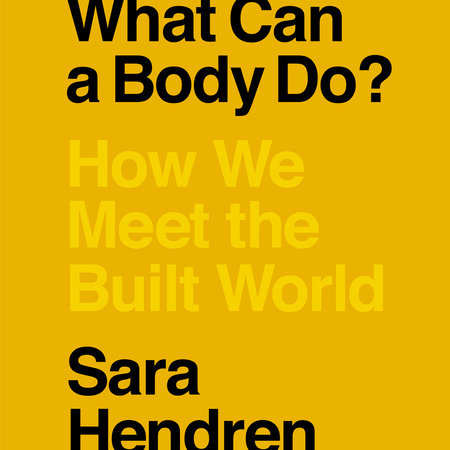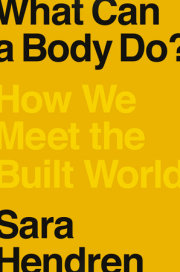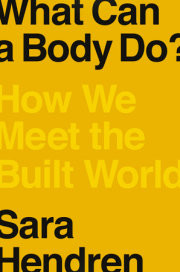INTRODUCTION: WHO IS THE BUILT WORLD BUILT FOR? Every day every body is at odds with the built environment. Bodies come up against stairs and sinks and subway plat‑ forms, sometimes with ease and grace and sometimes blun‑ dering and awkward, over hurdles, even in a sudden clash. Each flesh envelope is miraculous and mundane in this way, lugging all its gear and getting where it needs to go. Maybe you handle a sharp knife with enjoyment of its grip; maybe you wince as you sit down in or get up from your office chair. All the jostling around doorways and furniture, all the hustling down the crowded sidewalk—it would be a vast and endless choreography, a dance of one multiplied by millions, if you could see us all from above. How we meet the built envi‑ ronment depends on both bodies and worlds. There’s no custom-fit solu‑ tion arriving for any of us, but if you could zero in on that moment of body-meets-stuff—flesh up against metal or concrete or plastics—if you could slow down the tape right at the instant of connection, you’d see it packed with information. And no one understands this more than Amanda, who came to my suburban college campus outside Boston on a frigid day in January. She was one of the first guests invited to collaborate with a cohort of two dozen engineering students who’d signed up for my class in design that semester.
Amanda is an art historian and a curator of contemporary art. She is Australian by birth and still speaks in the lilt of her native accent, even as a longtime transplant to Southern California. She has a comfortably professorial air, at ease in the front of the room in the geometric clothing that’s favored by the gallery set, and she’s also a Little Person. Amanda has a form of dwarfism, so her stature, at just over four feet tall, is shaped outside the standard range of average heights for humans. Her entrance to an unremarkable college classroom is a whole curriculum unto itself, because her presence has a way of casting the surrounding environment into stark relief, making some of us pause and really see it, as if for the first time: the dimensions of the space, the heights of the light switches and various media outlets, the sizes of our tables and chairs.
Amanda arrived, laptop in tow, and walked my students through a visual overview of her work as a curator, pointing to slides as she talked about all the ways she works with artists and museums to bring an exhi‑ bition to life. She told us, for example, how she’d installed one contempo‑ rary photography show at a lower wall height than standard—making it more accessible to Little People but also to wheelchair users and to children. She invited the students’ many questions about how she presents her work, but also about her daily life and her experience of her body in the world, because she wasn’t just a guest lecturer. Amanda was with us because she had an idea, a proposal for all of us to take up as a project— she, together with me and my eager young engineering students. She had come to ask us to design and build with her a piece of furniture, a tool that would address some of the specific features and requirements of her profession and her body: a lectern, for giving talks and for welcoming audiences to her museum shows.
A lectern, it has to be said, is so often just the architecture for a lot of hot air—that tap-tapping on the microphone that careens into feedback before settling in for the drone of voices warming to their themes and standing between you and lunch. It plays such a sturdy supporting role in so many formalized rituals—commencements, sales pitches, seminars, sermons—that, at a glance, it hardly seems worth remarking on. Think how many lecterns there are, just standing around in anticipation in the world’s many hotel conference rooms and auditoriums, generic models covered in wood veneer and all more or less alike, a nondescript part of the background. Except: a lectern is also a blunt announcement, carried in the shape of an object, about who’s expected to be standing behind it. A lectern assumes a world where everything is created for people whose stature ranges from just over five feet and up.
Amanda wanted a lectern at her scale. She wanted to be able to do the speaking her job entailed without a device that required her to enact the repeated awkwardness of bringing her body to the dimensions of a room at odds with her physicality, usually some structure behind an ordinary lectern. “Typically, it would be some kind of little pedestal or something, right?” she told us. It was an accommodation she’d made do with for much of her life, but she didn’t want to do that anymore. She wanted a more flexible design. To present her master’s thesis in graduate school, she’d commissioned a wooden model on wheels; it was gratifying for that event but it was heavy, not really portable. She’d come to our class for a new version entirely, a lectern that had to do more than stand at the correct height. She wanted to take it with her when she traveled for work, so it had to be built in such a way that it would easily fold to a flat shape, and then open back up in elegant and simple steps. It had to be lightweight for easy carrying, spacious enough to hold her notes, robust enough to support her laptop and a bottle of water and hold up under repeated use. Nothing even close was available for purchase.
My students were easily captivated by the sheer mechanics of the chal‑ lenge. The entire classroom was clear-eyed, awake, eager to get going even on a winter morning. But there was still more to understand: Amanda would say she is disabled—not differently abled, not specially challenged, or any other similar variation. Like many people in the disability community, she would use that term by choice, preferring it even to
person with dwarfism. For her,
disabled is not a derisive word. Amanda would say very plainly that she lives with the disabling conditions of the world. She must bring her body to the built environment, with workarounds, in dozens of ways every day, and the qualities of that interaction, body meeting world, are what render her disabled. She finds, too, that
disabled as a descriptor connects her experience to other people with bodies that don’t easily match the built world, bodies both like and utterly unlike hers. It’s a subtlety that my nondisabled students had to consider at length to understand, and that my students with disabilities recognized in them‑ selves, whether visibly or not. But the unexpected language guided our unexpected project. The task in front of us would not be a tool for assist‑ ing Amanda’s body with the room. It would be the opposite—a tool for bringing the room, provisionally, to Amanda.
My students had signed up for my class expecting, quite reasonably, to use their engineering skills in a straightforward manner: designing and building prosthetics or assistive technologies for people who need them. Prosthetics or assistive technologies—tools and devices made for people whose bodies fall outside the established range of normal functioning. This would be their chance, they’d assumed, to apply all the skills they’d gathered thus far—all the mathematical equations they’d learned to run, all the fabrication practice they’d had in the wood and metal shops, all the principles of mechanics that they knew as the gorgeous underlying grammar of the physical world. In this first discussion with Amanda, their minds were already racing: Had she considered something inflatable? Or with a pop-out frame, like a tent? Building stuff, getting their hands dirty for a good purpose—this is what they had signed on for.
But they couldn’t have anticipated the presence of Amanda herself. She commands the room like the experienced public speaker she is, and here she was, at ease in her own body and presenting us with this singular re‑ quest. She wanted a product that was useful, yes, but its requirements weren’t just a technical list of needs. The request also came from Amanda’s wishes. It arose from her imagination—from her sense that the shape of the world might, in a small way, be made more flexible. Contrary to the students’ well-meaning assumptions, it actually wasn’t a prosthesis that she wanted, at least in the strict sense of a medical device. Instead, she was presenting us with an invitation to collaborate on a material object to suit a particular situation, one shared by relatively few other people: a lectern for short stature. A bespoke design for one person, at least at first glance.
Copyright © 2020 by Sara Hendren. All rights reserved. No part of this excerpt may be reproduced or reprinted without permission in writing from the publisher.










